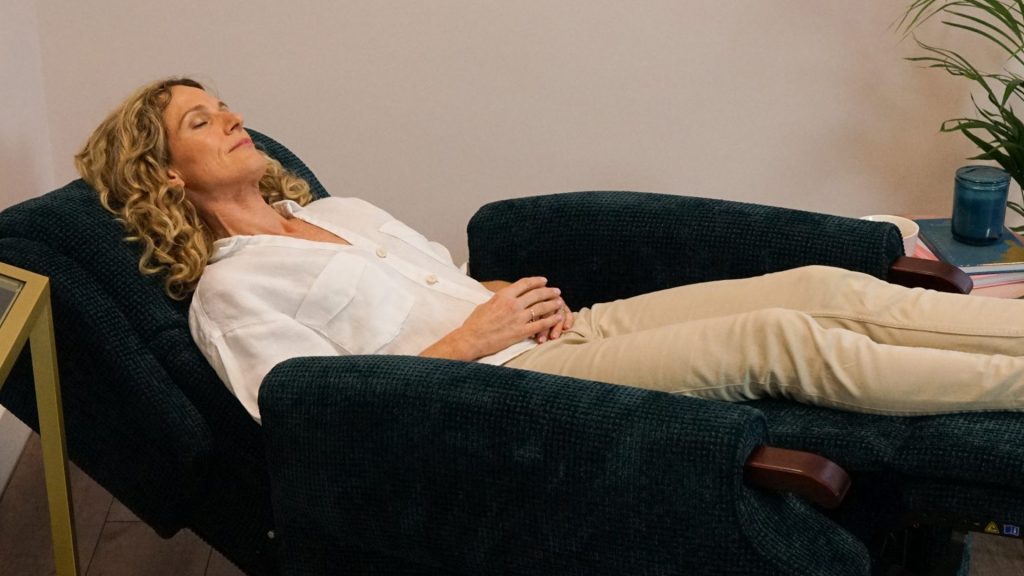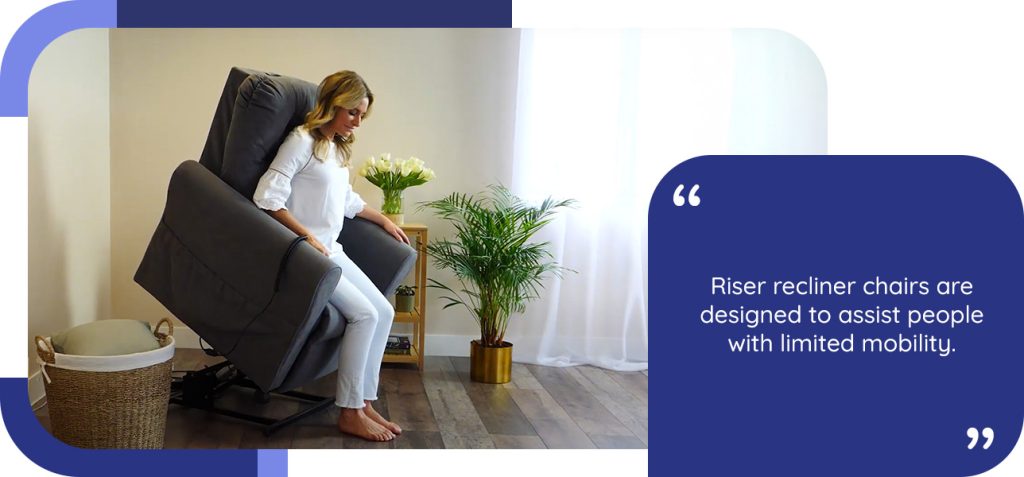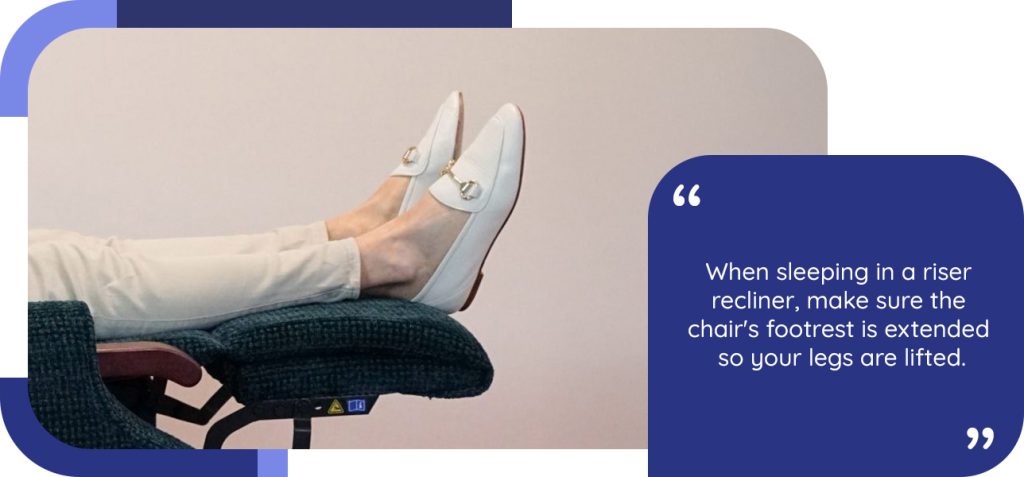Is it bad to sleep in a riser recliner chair?

Sleeping in an armchair or riser recliner chair is something many people do from time to time. Some individuals—especially older adults or those with certain health conditions—find it easier to fall asleep in a chair than in a bed. This might be because as we age, our sleep often becomes lighter and more easily interrupted, making a cosy recliner in the living room an appealing spot for dozing off. But is it bad to sleep in a riser recliner chair regularly?
Below, we explore the benefits and drawbacks of sleeping in a riser recliner chair, how it compares to sleeping in an adjustable bed, and tips to do it safely and comfortably.
Table of contents
- 1. Benefits of sleeping in a riser recliner chair
- 2. Drawbacks of sleeping in a riser recliner chair
- 3. Adjustable beds vs. riser recliners: which is better for sleep?
- 4. Tips for sleeping safely in a riser recliner chair
- 5. Find your perfect sleep solution – whether it’s day or night
1. Benefits of sleeping in a riser recliner chair
If you struggle to get comfortable in a bed, a riser recliner chair can offer some unique sleep benefits. Here are several potential advantages:
Eases acid reflux and heartburn
Sleeping slightly upright can help people who suffer from acid reflux or heartburn. Gravity plays a key role: when you lie flat, stomach acid can more easily flow back up into the oesophagus, but in an elevated position gravity helps keep acid down.
According to Guts UK, acid reflux (also known as gastro-oesophageal reflux disease, GORD) affects up to 1 in 4 UK adults. Standard advice for managing night-time reflux includes raising the head of your bed by about 10–20 cm or using extra pillows to prop up your upper body.
A riser recliner chair naturally keeps your body at an incline, which can reduce the frequency of reflux episodes at night. Many people with chronic heartburn find they can sleep more soundly in a reclined chair than flat in bed, as the upright angle helps prevent that burning sensation in the chest.
Reduces snoring and sleep apnoea symptoms
People with obstructive sleep apnoea (OSA) or heavy snoring might also benefit from sleeping in a more upright position. OSA occurs when throat tissues relax and block the airway during sleep, causing breathing to repeatedly stop and start. Lying flat on your back can worsen OSA because gravity pulls the tongue and soft tissues toward the airway.
By contrast, sleeping with your head and torso elevated can help keep the airway more open. This elevated sleeping position can often reduce snoring and mild apnoea symptoms by preventing gravity from narrowing the throat and airways.
Mild to moderate cases of sleep apnoea may see improvement when sleeping in a riser recliner chair or an adjustable bed, as raising the upper body can lessen airway collapse during the night. (Do keep in mind that OSA is a serious medical condition—if you suspect you have sleep apnoea, be sure to consult a doctor for proper diagnosis and treatment.)
Can alleviate night-time shoulder or upper back pain
If you have shoulder pain or upper back pain, you might find a reclined sleeping posture more comfortable than lying flat. Sleeping on your side in bed can put pressure on your shoulder joints and muscles, often making shoulder pain worse. Even if you start out sleeping on your back in bed, you might roll onto your side unconsciously and aggravate a sore shoulder.
A riser recliner chair offers a solution: it keeps you in a gently reclined position where you’re less likely to roll onto your side during sleep. This can relieve the pressure on painful shoulders andhelp prevent upper back pain. Some people with chronic shoulder pain report that dozing in a recliner allows them to sleep through the night with less discomfort compared to a flat bed.

Helps with mobility and circulation
Riser recliner chairs are designed to assist people with limited mobility, so sleeping in one can make certain routines easier. For example, if someone has trouble getting in and out of a low bed due to arthritis or weakness, a riser recliner can lift them to a standing position in the morning, reducing strain and the risk of falls.
Additionally, these chairs typically have built-in footrests that elevate the legs. Keeping your legs raised while sitting or sleeping can improve circulation and reduce swelling in the feet or ankles.
The NHS advises that if you have swollen legs or feet, you should try to raise your legs on a chair or pillows when resting, as this helps blood flow back to the heart. Thus, sleeping with your legs slightly elevated in a riser recliner might ease symptoms of oedema (fluid retention) in the lower limbs.
2. Drawbacks of sleeping in a riser recliner chair
While a riser recliner chair can be a comfortable temporary sleep solution for some, it’s not without downsides. Health experts generally do not recommend using an armchair or recliner as a permanent bed replacement. Here are some potential drawbacks and risks to consider:
Poor sleep quality and limited restorative sleep
One of the main issues with sleeping in a chair is that you might not get the same quality of deep, restorative sleep as you would in a bed. Recliners don’t offer the full-body support of a good mattress. If your neck or back isn’t properly supported, you may experience the familiar “head drop”—that sudden jolt when your head falls forward as you drift into deep sleep.
When we enter the REM stage of sleep, our muscles relax completely. In a chair, this can lead to your head flopping to one side or your posture collapsing, which jars you awake and interrupts the sleep cycle. The result can be a series of light naps rather than continuous deep sleep. Over an entire night, these frequent micro-awakenings leave you feeling unrefreshed and groggy the next day.
To mitigate this, if you do sleep in a recliner, make sure to recline the back at least 40° (so you’re not bolt upright) and support your head and neck with a cushion or headrest. Ensuring your arms and legs are propped in a comfortable position can also help.
Joint stiffness and back pain
Humans are meant to change positions during sleep. Shifting position periodically at night is normal and helps prevent stiffness. In a riser recliner, however, your movement is more restricted—you’re essentially sleeping in the same semi-seated posture all night. This can lead to stiff joints and muscle tightness by morning.
Your hips and knees remain bent for hours, which over time may cause shortening of certain muscles (hip flexors, calves, hamstrings) and could even affect your posture. Some people with existing back problems might find that long-term nightly use of a recliner aggravates their lower back pain.
Many doctors consider sidesleeping with a pillow between the knees to be one of the best positions for alleviating lower back pain. That position is nearly impossible to achieve in a chair. If your recliner doesn’t support the natural curve of your lumbar spine, sleeping in it every night could put extra pressure on your lower back.
Reduced circulation and DVT risk
Another concern with sleeping in a chair is its effect on circulation. Sitting still for prolonged periods can slow blood flow. You might notice your feet feel colder or your ankles look puffier after a night in a recliner, as gravity causes blood to pool in the lower extremities.
Medical experts warn that remaining in a seated or bent-leg position for too long can increase the risk of deep vein thrombosis (DVT)—a blood clot forming in the deep veins of the leg. DVT is a serious condition that can be life-threatening if the clot travels to the lungs (causing a pulmonary embolism).
The problem is that a reclined chair still keeps your knees and hips bent through the night, which can compress blood vessels and reduce circulation. To lower your risk of circulation problems when using a riser recliner, it’s important to move and stretch out as much as possible. For instance, fully extend the footrest to keep your legs as straight as you comfortably can.
Pressure sores and skin problems
Unlike a bed—which allows you to lie flat and shift positions—a chair concentrates pressure on a few areas of the body (mainly your lower back/buttocks, tailbone, and heels). Spending all night, every night in a riser recliner without changing position can lead to pressure ulcers (pressure sores) on these points, especially in individuals who already have fragile skin or limited mobility.
Healthcare professionals advise that anyone at risk of pressure ulcers should avoid sitting in one position for too long. The NHS recommends sitting out in a chair for no more than two hours at a time before returning to bed or repositioning. When you are sitting in a chair, you should try to shift your weight or change your position every hour to relieve pressure on the skin.
If you sleep through the night in a chair, you’re likely staying in roughly the same posture for 6–8 hours, which greatly increases the risk of pressure damage to the skin. If you must sleep in a recliner regularly due to health reasons, take precautions to protect your skin: use special pressure-relief cushions and, if possible, have a carer help you reposition your body at least a couple of times during the night.

3. Adjustable beds vs. riser recliners: which is better for sleep?
Riser recliner chairs can be very useful for occasional rest or for dozing off when you can’t get comfortable in a bed. However, they are not designed to be a full-time substitute for a proper bed. If you find yourself needing to sleep in a more upright position every night—for example, due to chronic reflux or breathing issues—an electric adjustable bed might be a healthier long-term solution.
Adjustable beds allow you to elevate the head (and/or foot) of the bed at various angles, essentially offering the same benefits of a recliner (helping with reflux, snoring, easier entry/exit) but with the space to fully stretch out your body. This means you can change positions more freely during sleep, reducing stiffness and pressure build-up over the night. With an adjustable bed, you can sleep on your side or back with your head raised, whereas a chair confines you to one position.
Another advantage of keeping the bed as your primary sleep space is related to sleep hygiene. Sleep experts often emphasise that your bed and bedroom should be dedicated to sleep—a quiet, dark environment free from distractions like television or mobile screens. Riser recliner chairs are typically located in living areas, where you might be tempted to fall asleep with the TV on or lights on. This can undermine your sleep quality.
By using an adjustable bed in your bedroom, you maintain a healthier routine: you go to bed in a sleep-conducive environment, and you get up from bed in the morning, which can psychologically reinforce better sleep patterns.
In summary, while a recliner chair can bridge the gap if you absolutely can’t sleep flat, an adjustable bed is usually the better choice for consistent nightly sleep. It gives you similar positional comfort without the downsides of restricted movement and a smaller sleeping surface.
4. Tips for sleeping safely in a riser recliner chair
If you decide to sleep in your riser recliner chair—either occasionally or out of necessity (for instance, during recovery from surgery or while managing a health condition)—follow these tips to make the experience safer and more comfortable:
Recline the chair appropriately
Don’t try to sleep in the chair at a 90° upright angle. Tip the backrest down to a semi-reclined position that supports your body. Most people sleep best when the chair is reclined at least 40–45 degrees from vertical.
Find an angle that keeps your torso elevated enough for your needs (for example, more upright to ease reflux or snoring) while still allowing your head and neck to be supported without falling forward.
Use pillows for support
Add a small pillow or rolled towel behind your lower back to maintain the natural curve of your spine. Use a neck pillow or cushion to cradle your head and prevent it from tilting to the side. You can also place a pillow under each arm if needed, to keep your shoulders relaxed and supported. If the chair’s built-in headrest is firm, a soft pillow can make it more comfortable for long periods.
Keep your legs elevated (but not crossed)
Make sure the chair’s footrest is extended so that your legs are lifted. Try not to leave your feet dangling or your knees bent at a sharp angle, as that can impair circulation in your legs. If your recliner doesn’t elevate your legs high enough, use an ottoman or footstool with a cushion so your feet are roughly level with (or slightly above) your hips. Elevating your feet helps blood circulate and reduces ankle swelling. Also, avoid crossing your legs while sleeping, as this can further restrict blood flow.
Stay warm (but avoid overheating)
Cover yourself with a comfortable blanket to keep warm through the night, since you won’t have a duvet as you would in bed. If your recliner is leather or vinyl, consider laying a cotton sheet or light throw over it—leather can make you sweat during prolonged contact. Wear breathable nightclothes and keep a spare blanket nearby in case you get chilly later in the night.
Maintain a bedtime routine
Treat sleeping in the chair similar to sleeping in a bed. Dim the lights, turn off the television and other screens, and try to keep the room quiet. Have essentials within reach (a glass of water, your medication, the TV remote or a book, etc.) so you won’t need to get up or twist around awkwardly. By creating a nightly routine, you signal to your body that it’s time to sleep—even if you’re not lying in a bed.
Move and stretch periodically
If you wake up during the night, take that opportunity to gently move your body. Even small adjustments—such as shifting your sitting position, straightening and re-bending your legs, or rolling your shoulders—can help restore circulation. Ideally, try to stand up and stretch at least once or twice during a long night in the chair.
Regular movement is crucial if you spend extended time in a chair; healthcare guidance is clear that keeping active (even with simple movements) helps prevent issues like pressure sores and DVT.
Listen to your body
Pay attention to any warning signs that sleeping in the chair might be harming you. For instance, if you notice tingling or numbness in your feet, calf cramps, or any new pain when you wake up, you may need to adjust your setup. Persistent aches or poor sleep quality are signs that this arrangement isn’t working well.
In such cases, consider alternating between the chair and a bed if possible, or speak with a healthcare professional for advice. You might benefit from a different solution (such as a customised mattress, an adjustable bed, or physical therapy exercises) to improve your sleep setup.

5. Find your perfect sleep solution – whether it’s day or night
Now that you understand both the benefits and limitations of sleeping in a riser recliner chair, you’re better equipped to make the right choice for your comfort and health. The truth is, there’s no one-size-fits-all answer – some people thrive with the elevated support of a recliner, while others need the full-body freedom that only a proper bed can provide.
Why settle for compromise when you can have comfort and quality sleep?
At Adjustamatic, we don’t believe you should have to choose between occasional comfort and nightly rest. That’s why we’ve spent decades perfecting both riser recliner chairs for your waking hours and adjustable beds for restorative sleep.
Here’s what makes our approach different:
- Dual expertise in comfort solutions: Whether you need to buy a riser recliner for afternoon relaxation and easier mobility, or an adjustable bed that gives you the elevation benefits without the circulation risks, we design each product with your specific needs in mind.
- Health-focused engineering: Our riser recliners feature therapeutic massage systems like NHC Cyclo-Therapy® and ergonomic support that make them ideal for managing conditions like arthritis or circulation issues. Meanwhile, our adjustable beds offer the same elevation benefits for acid reflux and breathing problems, but with the space and flexibility your body needs for proper sleep cycles.
- British craftsmanship you can trust: Every piece is handcrafted in our UK workshop with a focus on longevity and reliability. Our comprehensive warranties reflect our confidence in products built to support your daily comfort for years to come.
- Personalised guidance from sleep specialists: Our team understands that choosing between a recliner and an adjustable bed – or deciding if you need both – depends on your unique circumstances. We’ll help you navigate these decisions based on your health needs, living situation, and comfort preferences.
Ready to explore your options?
Whether you’re leaning toward a riser recliner for daily comfort, an adjustable bed for better nightly sleep, or considering how both might work together in your home, our specialists are here to help you find the right solution.
Book your free consultation today where we can discuss your specific sleep challenges and demonstrate how our products address the very issues highlighted in this guide – all in the comfort of your own home.
Call us today on 0800 689 9823 (lines open 9am-5pm Monday to Friday) or send us a message to request your free information pack. If you have qualifying health conditions, we can also guide you through potential VAT exemption benefits.
Don’t let another night of uncomfortable sleep pass by – discover how the right furniture can transform both your rest and your daily comfort.


